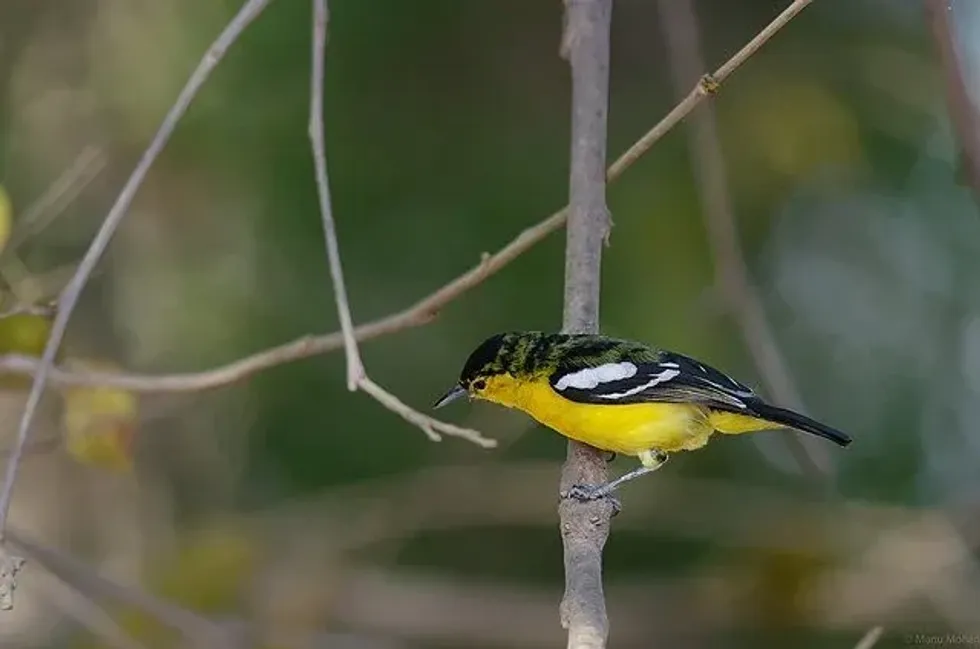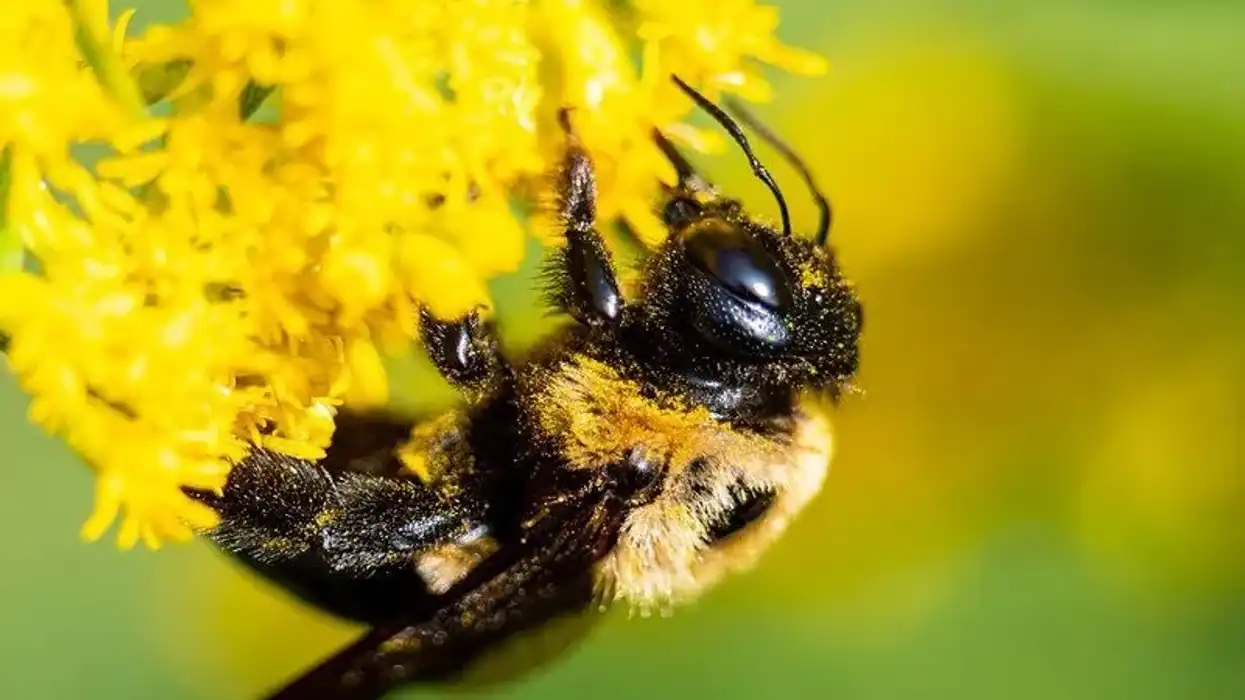Are you interested to know more about small green birds like the little bee-eater? If yes, then you are in the right place, as we are going to talk about one of the species of ioras.
Today, we have for you the beautiful yellow-greenish common iora that belongs to the family Aegithinidae and genus Aegithina. These species of ioras are especially found in the Indian subcontinent along with other South Asian and Southeast Asian countries.
In Southern India, a subspecies known as the Aegithina tiphia multicolor is found which has a bright green feathers.
You can easily spot this species by the male which has black wings and tail apart from its greenish-yellow body. It mainly feeds on insects and this species likes to stay hidden in the plumage of a tree.
During the breeding season, the upperparts and wings of the males get even brighter and the black color extends to its head. These cute little birds can be spotted in Southern and Northern India and it is remembered for the long whistling call.
Want to know more about this species? Keeping reading to get common iora facts. Also, check out the articles on lorikeet and aquatic warbler to find out about other birds.
Common Iora Interesting Facts
What type of animal is a common iora?
The common iora is a bird belonging to the Passeriformes order and it's known for the bright yellow plumage.
What class of animal does a common iora belong to?
The common iora belongs to the class Aves, order Passeriformes, family Aegithinidae, and Aegithina genus. Similarly, the pitta bird is another common Passeriformes that are commonly found in various parts of the world.
How many common ioras are there in the world?
As this is a commonly found bird in countries like India and Sri Lanka along with other Southeast Asian countries it's hard to get its exact population.
Where does a common iora live?
The common iora is especially known for belonging from the Indian subcontinent where it's found in India, Sri Lanka, Bangladesh, and other surrounding countries. These beautiful birds are also found in many countries of Southeast Asia like Thailand and the Malay Peninsula.
Moreover, this bird species is further divided into several subspecies based on its geographical locations, so we cannot call it endemic to a particular place.
What is a common iora's habitat?
The habitat of the common iora varies according to its geographical location. Apart from mangroves with closed canopies, these birds are also found in strand woodland and coastal scrub areas.
These birds have a fondness for casuarina scrubs and they can also be present in bamboo thickets, orchards or gardens. The ioras do at times get to the suburban areas especially in search of food. In Southeast Asia, the populations of these birds can be usually seen in montane habitats.
Who do common ioras live with?
The common iora is a fairly social bird and it looks for food in small flocks. Even mixed flocks are seen where this bird teams up with other species to hunt for insects. These birds can often venture to the edges of a forest or wooded area to search for food.
How long does a common iora live?
We aren't aware of the lifespan of the common iora.
How do they reproduce?
One of the most distinct things about the common iora is the breeding plumage of the male birds, and the male performs an acrobatic courtship display for females. The breeding season in India and the surrounding countries last between January to September, while in Thailand it's from March to June.
However, the monsoon plays an important role in bringing the breeding season of the common iora.
The birds usually make a cup-shaped nest in the fork of a tree and the nest is lined with materials like fine grass and tree cotton.
The female lays around two to three greenish-white eggs depending on the location and both the breeding male and female birds take turns incubating the eggs for up to 14 days. It's also said that the breeding male often sings close to the nest.
What is their conservation status?
The Red List of the International Union for Conservation of Nature currently places the common iora under the status of Least Concern and notes the distribution of populations of this bird is quite common in its natural range.
Common Iora Fun Facts
What do common ioras look like?
When it comes to the common iora, the most important thing about it is the description of its beauty. The yellow-green plumage of this bird species is phenomenal.
And, the contrast of black and white bars on the upper parts of wings make it even more eye-catching. According to the geographical area, there might be a little difference in the appearance which has led to the division of it into different subspecies.
The multicolor subspecies present in southern India and Sri Lanka are thought to be one of the most widely found variants of this bird species. To give a simple description of the iora common species, we have to say that the bird is covered with yellow-green plumage which is duller in the underparts.
However, some may even have bright yellow feathers on the underpart. On the upper parts of the wings, you will find gray, black, and white stripes.
In the breeding male and the non-breeding male, the black wing is commonly seen.
However, the breeding male also develops a broad black line on the upper parts of its head. The male displays its beautiful breeding plumage by air fluffing its feathers, pale green rump, and wings during the breeding season.
Coming to the rest of the body, the tail usually has grayish-yellow feathers while the male often has a black tail. Now, the non-breeding plumage, as well as the shade of green or yellow, may change according to the subspecies and taxonomy divisions.

How cute are they?
The common iora (Aegithina tiphia) is a small and extremely cute bird that looks phenomenal because of its yellow-green plumage. Its cuteness can be compared to that of the rainbow bee-eater bird.
How do they communicate?
Not a lot is known about the female common iora (Aegithina tiphia) birds. However, the male is known to have a noisy whistling call which is said to be a mix of wheeeee-tee and churrs. This bird is also said to mimic the calls of other birds such as the drongos.
How big is a common iora?
The average size range of the common iora is around 4.9-5.3 in (12·5–13·5 cm). Compared to it, the lark sparrow has an average size range of 5.9-6.7 in (15-17 cm) making it slightly bigger than the iora.
How fast can a common iora fly?
We aren't aware of the flight speed range of the common iora.
How much does a common iora weigh?
The average common iora (Aegithina tiphia) weight range is around 0.4-0.6 oz (12-17 g).
What are the male and female names of the species?
There are no separate names for the male and female of this bird species. The only way to tell apart the male from females is during the breeding season when the male has breeding feathers. But, the non-breeding male looks quite similar to the female.
What would you call a baby common iora?
A baby common iora is known as a chick.
What do they eat?
The diet of a common iora (Aegithina tiphia) usually includes insects and arthropods. It has also been suggested that some subspecies may also have fruit in the diet. Common foods found in its diet includes beetles, mantids, and caterpillars. The iora common bird hunts for its food mainly among the twig and leaves of the plants.
Are they dangerous?
No, the common iora (Aegithina tiphia) is a really sweet bird and it can't be dangerous to anyone except its favorite food, the insects.
Would they make a good pet?
No, this bird isn't meant to be kept as a pet. However, in the Indian subcontinent, you can often come by this bird in suburban areas.
Did you know...
The most common subspecies of this bird include Aegithina tiphia multicolor (Southern India), Aegithina tiphia deignani (Myanmar), Aegithina tiphia humei (Eastern India), Aegithina tiphia tiphia (North India, Bangladesh, Myanmar), Aegithina tiphia septentrionalis (North-west and North India), Aegithina tiphia aequanimis (Philippines and Borneo), Aegithina tiphia scapularis (Java, Bali), Aegithina tiphia philipi (China, Myanmar) to name a few.
The common iora or Aegithina tiphia moults twice a year.
This bird species formerly had the scientific name of Motacilla tiphia, but it been changed to Aegithina tiphia.
Do common ioras whistle?
Yes, the common iora (Aegithina tiphia) male is said to have a noisy whistling song that can go on for quite a long time.
How many eggs do the common ioras lay?
The common iora (Aegithina tiphia) lays around two to three eggs in a duration of around 48 hours.
Here at Kidadl, we have carefully created lots of interesting family-friendly animal facts for everyone to discover! For more relatable content, check out these Willow warbler facts and common raven facts pages.
You can even occupy yourself at home by coloring in one of our free printable Island Birds coloring pages.
Main image by Manu.mohan and second image by Abir Mahmud.










